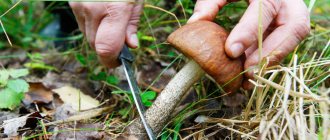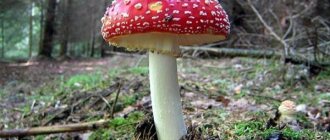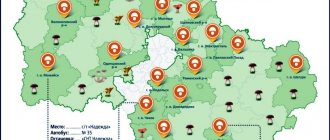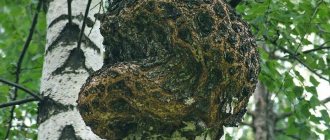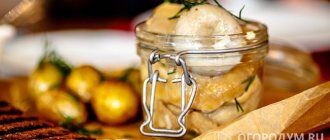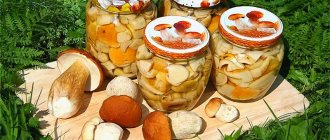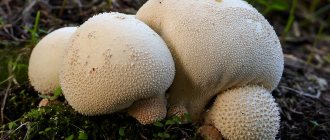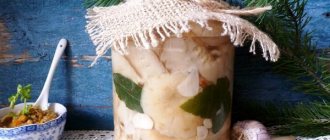We invite you to learn about all the varieties of mushrooms that look like white milk mushrooms and read their full characteristics in order to know which ones are conditionally edible and which ones are deadly poisonous. This information will help you avoid mistakes during a forest “silent hunt” and protect you from unintentional poisoning. So, read about what mushrooms are similar to white milk mushrooms and by what signs they can be distinguished in the field without special equipment.
Be sure to look at the mushroom that looks like a white milk mushroom in the photo and remember that you should never take it, as it is very poisonous.
Real breast milk (white)
True white milk mushroom grows in birch forests and mixed forests with an admixture of birch. It is found quite rarely, but sometimes in large groups, from July to October. The cap is large, up to 20 cm in diameter, in young mushrooms it is white, rounded-convex, then funnel-shaped, with a shaggy edge turned down, white or slightly yellowish, often with faintly noticeable watery concentric stripes. In damp weather it is mucous, which is why this mushroom is called “raw milk mushroom”. The pulp is white, dense, brittle, with a spicy odor. The milky juice is white, acrid, bitter in taste, and turns sulfur-yellow in air. The plates descending along the stalk, white or cream, with a yellowish edge, wide, sparse. The stem is short, thick, bare, white, sometimes with yellowish spots, and in mature mushrooms it is hollow inside. Conditionally edible, first category. Used for pickling, less often for pickling. Salted milk mushrooms have a bluish tint.
Habitat
As a rule, milk mushrooms grow in groups, at a distance of several meters from each other. If you come across one mushroom, carefully examine the clearing; most likely its “brothers” are hidden under the foliage nearby.
Milk mushrooms are found throughout the Russian Federation and prefer mixed or deciduous forests. The peak of mycelium development and harvest ripening occurs in autumn; the duration of fruiting depends on the region and the climatic characteristics of the region.
Let's devote a few words to the rarer brother of the mushroom we are considering - the black milk mushroom. If you see a plant identical in shape, but different in brown color, in a deciduous thicket or pine forest, it may be an edible black milk mushroom. You can verify this by smelling the fruit, as well as lightly pressing on its flesh - if the surface is darkened and the aroma is pleasant, feel free to collect the delicacy you find.
White mushrooms, similar to milk mushrooms (with photo)
There are various white mushrooms that are similar to milk mushrooms and it is important to be able to recognize them by their smallest differences. They confuse white milk mushrooms, of course, with violins - dry, hard porcini mushrooms, like two peas in a pod, similar to white milk mushrooms. Mycologists also cannot come to an agreement - in this family of milk mushrooms, someone else distinguishes the aspen white milk mushroom (although this is the same violin that grows in symbiosis with aspens, like the boletus), someone else distinguishes the white milk mushroom. In general - confusion. The same goes for edibility. Respected authors are completely confused, they gave the violin conditional edibility, but the aspen mushroom, in their opinion, turns out to be inedible.
Yellow milk mushrooms are very similar to real milk mushrooms. They have approximately the same size, the edges of the caps are also pubescent and turned down. They are similar in taste. They just have an intense yellow color. It grows mainly in birch forests, less often in coniferous forests. Found singly or in groups from July to October. A large mushroom, similar in appearance and size to a real milk mushroom, but different in color. It has a golden-yellow cap with faintly defined dark concentric zones and a shaggy edge turned down, first round-convex, then funnel-shaped. The flesh of the mushroom is white, turning yellow when touched and when broken. When damaged, it produces a white milky sap, which is caustic and turns yellow in dry weather when exposed to air. The leg is short, narrowed downwards, pale yellow, with dark spots, mucous. Conditionally edible, first category, suitable for pickling and pickling. The taste is not inferior to real milk mushrooms.
Symptoms of poisoning and first aid
Typically, the first indicators of mushroom poisoning appear 1.5–2 hours after eating them.
The person begins to feel:
- nausea and vomiting;
- weakening of the pulse;
- temperature increase;
- painful inflammatory sensations in the abdomen;
- cooling of the extremities.
This is followed by frequent diarrhea. The pain does not go away, it is very strong. The first necessary actions when signs of poisoning appear are:
- Call a doctor immediately.
- Maintain bed rest.
- Drink plenty of water or cool, strong tea.
- Take activated carbon.
Never forget that all mushrooms can only be collected in environmentally friendly areas. Collecting milk mushrooms and other forest products requires not only good theoretical knowledge (description, taking into account the main differences and the presence of pronounced characteristics), but also experience. Nutrients and vitamins, original forest taste and aroma are positive and important characteristics of mushrooms. But there are also dangerous aspects: toxicity and improper processing.
Aspen milk mushroom
Aspen milkweed grows in damp aspen and poplar forests. Occurs rarely, singly or in groups, from July to October. The cap is up to 20 cm in diameter, at first convex, then funnel-shaped, with fringed edges turned downwards, off-white with pinkish or watery concentric zones, mucous in wet weather. The pulp is white, without noticeable odor and burning taste. The milky juice is white and does not change in air. The plates descending along the stalk, whitish or slightly pinkish, very frequent. The leg is short, thick, dense, narrowed at the bottom, mealy in the upper part, white or the same color as the cap. Conditionally edible, second category. Suitable for pickling only.
Gorchak
Description
More similar to boletus, sometimes it is confused with boletus.
It is inedible because no measures can remove the bitter, nasty taste. If at least one representative gets into the soup, the dish will be spoiled irrevocably.
The bitterness does not break down during heat treatment, but is enhanced many times over.
If a specimen was found near a rotten stump and was never bitten by anyone, despite its impressive size, then rest assured that it is a bitterling.
How is it different from milk mushrooms?
It does not look like milk mushroom at all; it is impossible to confuse it with agaric mushrooms.
Externally, it slightly matches the white one: it is also stocky, stands confidently on a strong thick leg, the inside of the cap is spongy.
You can distinguish it only by taste. It is enough to lightly lick the edge - if you feel bitterness, you should immediately rinse your mouth and throw the mushroom away.
Also pay attention to the stem on the cut: in bitterling it turns pink.
Pepper milk mushroom
Pepper milkweed grows in deciduous forests with an admixture of oak and birch. Found in July–October quite often and in large groups. The whole mushroom is white at first, then with a yellowish tint. The cap is up to 20 cm in diameter, fleshy, dense, at first flat, with a curled edge, then funnel-shaped, matte, dry. The pulp is white, when cut it becomes bluish-blue, with a spicy peppery taste. The milky juice is abundant, white, and turns blue in the air. The plates are white or cream, very frequent, narrow, descending along the stem. The leg is short, dense, smooth, white, sometimes with depressed spots. Conditionally edible, fourth category. Used for salting and pickling after boiling.
Toadstool
Description
Some of the most poisonous mushrooms look quite harmless, showing off to others a white, graceful fruiting body and a thin skirt around a long stem.
The cap is round, sometimes covered with small scales. The leg is thin, the connection to it in young grebes is covered with a film. Sometimes intricate patterns appear on the surface, having a pale greenish tint.
How is it different from milk mushrooms?
Most of all, the toadstool resembles a wild champignon, but sometimes it is mistaken for a milk mushroom.
The main difference is considered to be a kind of volumetric ring at the base of the leg, similar to a cup. Edible mushrooms do not have such an addition.
Another sign is the shape and pale (almost green) color of the cap, a light fruiting body, as well as the habit of growing alone or in a very dense group, literally crushing its neighbors.
Violin
The fiddler is quite often found in coniferous and deciduous forests of the middle zone, in large groups, from mid-June to mid-September. The cap is up to 20 cm in diameter, at first flat-convex, depressed in the middle, with a curled edge. Later it becomes funnel-shaped with a wavy, often cracked edge. The surface is dry, slightly pubescent, pure white, later slightly buffy. The plates are sparse, whitish or yellowish. The leg is up to 6 cm long, thick, somewhat narrowed at the base, solid, white. The pulp is coarse, dense, white, later yellowish, with abundant white, pungent, pungent milky juice.
The collected mushrooms in the basket rub against each other and make a characteristic creaking sound.
For this they were called “violinists”, “creakers”. Mushroom pickers do not always take these mushrooms, although they are used for salting, becoming strong and acquiring a mushroom smell. The mushroom becomes white with a bluish tint and squeaks on the teeth.
Snack
If you can’t imagine any feast without a mushroom appetizer, pay attention to the method of canning salted milk mushrooms. The recipe is based on the presence of five kilograms of the fruits we are considering. In addition to mushrooms, you will need: 180-200 grams of salt, peppercorns, dill, fresh garlic (not granules), bay leaf, vinegar, spices to taste and fresh currant leaves. Step-by-step instruction:
- Boil or prepare pre-soaked fresh milk mushrooms.
- Work on the brine according to the calculations: per liter of liquid there are 1.5 tablespoons of salt, 5 tablespoons of vinegar with a sharpness of 5 percent, spices, seasonings and leaves to taste (some gourmets add a few teaspoons of sugar).
- As soon as the brine is ready, you need to place the mushrooms in it and leave the preparation to infuse for 30 days.
- Has the specified period of time passed? Rinse the mushrooms, prepare the brine again (a “softer” one is possible), place the fruiting bodies in jars, and fill them with brine and set them to sterilize. After 50-70 minutes, the jars can be rolled up with lids.
Poisonous mushroom that looks like a white milk mushroom
A poisonous mushroom that looks like a white milk mushroom is a gray-pink milkweed and it is absolutely inedible and deadly to humans.
The cap is 4-12 cm in diameter, densely fleshy, convex or flat-spread to funnel-shaped, sometimes with a tubercle, initially with a bent edge and later with a drooping edge, dry, silky-fibrous, finely scaly, almost naked with age, ocher-fleshy-reddish, ocher -dirty pinkish-gray or pinkish-brown, with vague spots when drying. The plates are descending, narrow, thin, whitish, later pinkish-cream and orange-ocher. The stalk is 4–8–0.8–3.5 cm, cylindrical, dense, eventually hollow, tomentose, hairy-feltose at the base, the color of the cap, lighter in the upper part, mealy. The pulp is yellowish with a reddish tint, the lower part of the stem is reddish-brownish, sweet, without much odor (when dried, it smells of coumarin); The milky juice is watery, sweet or bitter, and does not change color when exposed to air. Growth. Grows in moist coniferous and deciduous forests. Fruiting bodies are formed in July – October. Poisonous mushroom.
Useful qualities, contraindications
The chemical composition of the mushrooms we are considering can give a head start to healthy fish or hearty meat. The pulp of the delicacy is literally oversaturated with a huge amount of minerals and other useful substances, namely:
- Vitamins of groups BB, C, D.
- Phosphorus, potassium, calcium.
- Ascorbic acid, carotene.
- Magnesium, sodium, phosphorus.
If we consider the product from the point of view of BZHU, the fruiting bodies are saturated with proteins, carbohydrates, and also protein, which is easily absorbed by the human body.
Each product has certain benefits or harm to the human body. Let's note the positive effect that white milk mushroom has on health:
- Strengthens the immune system and gives vitality.
- Stabilizes the functioning of the central nervous system.
- Improves blood circulation and regulates the functioning of the cardiovascular system.
- Strengthens hair, nails, bones.
- Can serve as an antibacterial agent.
- Prevents infection with tuberculosis.
- Reduces blood cholesterol levels.
- Facilitates the course of kidney diseases.
White milk mushroom is widely popular among representatives of traditional medicine, as all kinds of tinctures, extracts and pickles are prepared on its basis.
As for contraindications, of course, they also exist. People suffering from problems with the gastrointestinal tract should treat this treat with caution. As you know, any mushroom is considered a heavy food, which means it can cause indigestion or even intoxication.
The same rule should be followed by those whose liver and pancreas periodically fail. Another group of people in the “risk zone” are elderly, weakened citizens, pregnant or nursing mothers, and small children with weak digestion.
Those whose medical records contain diseases such as renal failure, hypertension, and gastritis should also limit themselves in eating milk mushrooms.
Allergy sufferers and those whose bodies have been found to be individually intolerant to certain components of natural gifts should pay particular attention to the product.
This is where the restrictions end. Remember, any product is useful if you use it in moderation.
